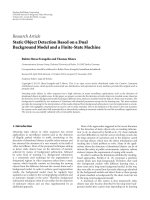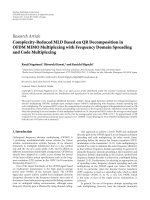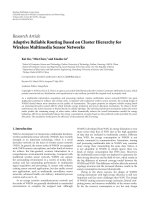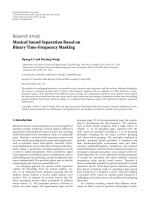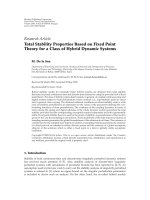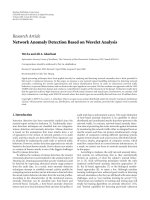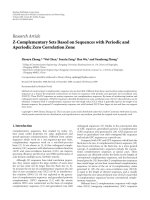Báo cáo hóa học: "Research Article Model Compensation Approach Based on Nonuniform Spectral Compression Features for Noisy Speech Recognition" docx
Bạn đang xem bản rút gọn của tài liệu. Xem và tải ngay bản đầy đủ của tài liệu tại đây (858.82 KB, 7 trang )
Hindawi Publishing Corporation
EURASIP Journal on Advances in Signal Processing
Volume 2007, Article ID 32546, 7 pages
doi:10.1155/2007/32546
Research Article
Model Compensation Approach Based on
Nonuniform Spectral Compression Features for
Noisy Speech Recognition
Geng-Xin Ning, Gang Wei, and Kam-Keung Chu
School of Electronic and Information Engineering, South China University of Technology, Guangzhou 510640, China
Received 8 October 2005; Revised 20 December 2006; Accepted 20 December 2006
Recommended by Douglas O’Shaughnessy
This paper presents a novel model compensation (MC) method for the features of mel-frequency cepstral coefficients (MFCCs)
with signal-to-noise-ratio- (SNR-) dependent nonuniform spectral compression (SNSC). Though these new MFCCs derived from
a SNSC scheme have been shown to be robust features under matched case, they suffer from serious mismatch when the reference
models are trained at di fferent SNRs and in different environments. To solve this drawback, a compressed mismatch function is
defined for the static observations with nonuniform spectral compression. T he means and variances of the static features with
spectral compression are derived according to this mismatch function. Experimental results show that the proposed method is
able to provide recognition accuracy better than conventional MC methods when using uncompressed features especially at ver y
low SNR under different noises. Moreover, the new compensation method has a computational complexity slightly above that of
conventional MC methods.
Copyright © 2007 Geng-Xin Ning et al. This is an open access article distributed under the Creative Commons Attribution
License, which permits unrestricted use, distribution, and reproduction in any medium, provided the original work is properly
cited.
1. INTRODUCTION
The problem of achieving robust speech recognition in noisy
environments has aroused much interest in the past decades.
However, drastic degradation of performance may still oc-
cur when a recognizer operates under noisy circumstances.
Resolutions to this problem can be generally divided into
three categories: inherently robust feature representation [1],
speech enhancement schemes [2], and model-based com-
pensation [3–6]. More details are reviewed in [7]. Recently,
different speech analyses based on psychoacoustics have been
reported in the literature [8]. The well-known perceptual
linear prediction (PLP) [9] uses critical band filtering fol-
lowed by equal-loudness pre-emphasis to simulate, respec-
tively, the frequency resolution and frequency sensitivity of
the auditory system. Cubic-root spectral magnitude com-
pression with a fixed compression root is subsequently used
to approximate the intensity-to-loudness conversion. How-
ever, it is suboptimal to use a constant root for compress-
ing all the filter bank outputs, because employing a constant
compression root would over-compress some outputs and
under-compress other outputs at the same time.
A new kind of noise-resistant feature by employing a
SNR-dependent nonuniform spectral compression scheme
was presented in [1], which compress the corrupted speech
spectrum by a SNR-dependent root value. [1] has shown
that the SNSC derived mel-frequency cepstral coefficients
(SNSC-MFCC) features are able to provide recognition accu-
racy better than the conventional MFCC features and cubic-
root compressed features. In a SNSC scheme, the compressed
speech spectra in the linear-spectral domain, Y
k
, is expressed
as
Y
k
= (Y
k
)
α
k
for 0 ≤ α
k
≤ 1, Y
k
> 1, (1)
where Y
k
is the kth mel-scale filter bank output of a cor-
rupted speech segment and α
k
is the compression root for the
kth filter band, which is SNR-dependent. However, since α
k
is
SNR-dependent, estimation of noise is required in the train-
ing session for finding α
k
under a particular noise type and
global SNR. Thus models estimated by training in this way
should only be used for a recognizing task under the same
global SNR and noise environment.
So as not to reestimate the model when adopting a SNSC
scheme, we need to compensate the models for the mismatch
2 EURASIP Journal on Advances in Signal Processing
caused by the compression root. This paper presents a com-
pensation scheme to compensate the recognition models
trained with clean and uncompressed training data for mel-
frequency cepstral coefficients SNSC-MFCC features in var-
ious noisy environments. In this scheme, we start with using
conventional MC methods such as the PMC [3, 4] method
or the VTS [6] approach, to produce compensated mod-
els for features of no compression. The means and vari-
ances of the compressed mismatch function are derived in
the paper. With the use of Gaussian-Hermite numerical in-
tegrals [10], a model compensation procedure is developed.
Most importantly, the new compensation scheme is applica-
ble to any conventional model compensation method. The
experimental results of the paper show that the new com-
pensated models provide very good accuracy in recognizing
SNSC-MFCC features at different SNRs in different noisy
environments. The computational complexity of the pro-
posed M C-SNSC method is comparable with conventional
MC methods. We call our new scheme the model compensa-
tion approach based on SNR nonuniform spectral compres-
sion (MC-SNSC).
The structure of this paper is as follows. The SNSC
method is br iefly reviewed in Section 2.InSection 3,wewill
introduce the MC-SNSC approach. Series of experimental
results along with discussion and analyses are then presented
in Section 4. Our conclusions on this study will be given in
the final section.
2. SNR-DEPENDENT NONUNIFORM
SPECTRAL COMPRESSION
The functional diagram of the generation of SNSC-MFCC
features is depicted in Figure 1. The testing utterance is seg-
mented into frames using a Hamming window. The fre-
quency spectra of the speech segments are computed via
discrete Fourier t ransform (DFT). Their squared magnitude
spectra are passed to the mel-scaled filter bank. After the mel-
scaled bandpass filtering , the spectral compression is applied
totheoutputsasin(1). Taking the log of the compressed
outputs and then the discrete cosine transform, we obtain
the SNSC-MFCC features.
Simulated by the spectrally partial masking effect, the
compression function α
k
is defined as
α
k
=
1 − A
0
1 − e
−[log(Y
k
/
N
k
)−β]/γ
·
u
log
Y
k
N
k
−
β
+ A
0
,
(2)
where A
0
is the floor compression root, β is the cutoff pa-
rameter to function as the just-audible threshold, γ is the
parameter to control the steepness of the compression func-
tion, and u(
·) is the unit step function. For SNR less than the
cutoff,(2) yields the floor compression value. The compres-
sion function produces small α
k
at a steep rate of change for
small band SNR above the cutoff and large α
k
asymptotically
close to one at a gradual rate for large band SNR. This SNSC
scheme renders the filter bank outputs of low SNR less con-
Windowed noisy speech signal
y(n)
Squared magnitude of DFT
P(i)
Mel-scaled band-pass filter
Y
k
=
i
ω
k
(i)P(i)
Spectral compression
Y
k
= Y
α
k
k
Log followed by DCT
SNSC-derived MFCC
(static feature)
Filter-bank output energies
of the noise estimate
N
k
Band SNR
estimation
SNR
k
= log
Y
k
N
k
Compression root
calculation
α
k
Y
k
Figure 1: Procedure of the SNSC scheme.
tributed to the resulting speech features while the outputs of
high SNR are largely emphasized.
The mismatch function Y
k
of the kth mel-filter bank out-
put, which is modeled as the sum of the noise energy N
k
and
the clean speech energy X
k
in the linear-spectral domain, is
expressed as
Y
k
= X
k
+ N
k
. (3)
We define the clean speech and noise segment in the Log-
spectral domain as X
(l)
k
and N
(l)
k
, respectively, then the mis-
match function in the log-spectral domain is expressed as
Y
(l)
k
= log
e
X
(l)
k
+e
N
(l)
k
. (4)
Thus the compressed mismatch function for the SNSC in the
log-spectral domain is expressed as
Y
(l)
k
= α
k
Y
(l)
k
,(5)
where
α
k
=
1 − A
0
1 − e
−(Y
(l)
k
−N
(l)
k
−β)/γ
·
u
Y
(l)
k
− N
(l)
k
− β
+ A
0
.
(6)
In this paper, we make the following assumptions in or-
der to facilitate the derivations of the MC procedures. (1) The
recognition model is a standard HMM with mixture Gaus-
sian output probability distributions. The transition prob-
abilities and mixture component weights of the models are
assumed to be unaffected by the additive noise. (2) The back-
ground noise is additive, stationary, and independent of the
speech.
The notations for the description of variables in the pa-
per are defined as follows. The superscripts (l) mean the
Geng-Xin Ning et al. 3
Clean
speech
Corrupted
speech
Noise
MFCC feature extraction
with spectral compression
Speech
recognition
Recognition
result
Noise
spectrum
Band SNR estimation
and compression root
calculation
Compensated
HMMs
MC-SNSC
Testing Noise HMMs
Training
Clean
speech
Clean speech
HMMs
MFCC feature extraction Model training
α
k
α
k
Figure 2: Processing stages for MC-SNSC approach.
log-spectral domains. When the variables have no super-
script, they are the variables in the linear-spectral domain.
The model parameters of the background noise model and
the noise-corrupted speech model are capped with
and ,
respectively.
3. MODEL COMPENSATION APPROACH BASED ON
THE SNSC SCHEME
Figure 2 shows the functional diagram of the recognition sys-
tem using model compensation for SNSC-MFCC features.
In the training phase, clean speech HMMs are trained from
standard MFCC features of which no compression is applied
or the compression root is just equal to one. During the fea-
ture extraction in the testing phase, the SNSC scheme as de-
scribed in (1) is used to compress each filter bank output. The
clean HMMs a re combined with the noise model to construct
the corrupted speech models to recognize the SNSC-MFCC
features using MC-SNSC approach.
There are no closed-form solutions for the moments of
the mismatch function in (5)and(6). The expectations are
multidimensional integrals for which we need to use compu-
tationally expensive numerical integrations to calculate the
model parameters. With the use of assumption (2) and an
additional assumption that the two random variables Y
(l)
k
and N
(l)
k
are uncorrelated, we can reduce the dimensionality
of the integration. Using the Gauss-Hermite numerical in-
tegral method, we derive the procedures for computing the
means and variances of the static features in the log-spectral
domain in the next subsections.
3.1. Mean compensation
Using the compressed mismatch function described in (5),
the mean of the static SNSC-MFCC feature in the log-
spectral domain is given by
μ
(l)
Y
k
=
1 − A
0
·
E
Y
(l)
k
· u
Y
(l)
k
− N
(l)
k
− β
−
E
e
−(Y
(l)
k
−N
(l)
k
−β)/γ
· Y
(l)
k
· u
Y
(l)
k
− N
(l)
k
− β
+ A
0
· E
Y
(l)
k
.
(7)
For the sake of simplifying the expression, we define
g(γ)
= E
e
−(Y
(l)
k
−N
(l)
k
−β)/γ
Y
(l)
k
u
Y
(l)
k
− N
(l)
k
− β
. (8)
Then the mean parameters of the static corrupted and com-
pressed features are expressed as
μ
(l)
Y
k
=
1 − A
0
g(∞) − g(γ)
+ A
0
· μ
(l)
Y
k
. (9)
Using the Gauss-Hermite integral, g(γ) is calculated as
g(γ)
=
Σ
(l)
Y
kk
2πΨ
k
e
−[Φ
k
+Ψ
k
/(2γ)]
2
/2Ψ
k
+ Ω
k
S(γ)
e
(Φ
k
+Ψ
k
/(2γ))/γ
(10)
with
S(γ)
∼
=
1
2
−
1
2
√
π
n
i=1
ω
i
erf
⎛
⎝
Σ
(l)
N
kk
Σ
(l)
Y
kk
t
i
+
Φ
k
+ Ψ
k
/γ
2
Σ
(l)
Y
kk
⎞
⎠
,
(11)
where Φ
k
= μ
(l)
N
k
− μ
(l)
Y
k
+ β, Ψ
k
=
Σ
(l)
N
kk
+
Σ
(l)
Y
kk
, Ω
k
= μ
(l)
Y
k
−
(1/γ)
Σ
(l)
Y
kk
,anderf(·) is the error function. The parameters t
i
and ω
i
for i = 1ton are, respectively, the abscissas and the
weights of the nth-order Hermite polynomial H
n
(t)[10].
4 EURASIP Journal on Advances in Signal Processing
3.2. Variance compensation
The diagonal elements of the covariance matrix of the SNSC-
MFCC static features are given by
Σ
(l)
Y
kk
= E
Y
(l)
k
2
−
μ
(l)
Y
k
2
=
1−A
0
2
f (∞)−2
1 − A
0
f (γ)
+
1 − A
0
2
f
γ
2
+ A
0
2
·
μ
(l)
Y
k
2
+
Σ
(l)
Y
kk
−
μ
(l)
Y
k
2
,
(12)
where
f (γ)
= E
Y
(l)
k
2
· e
−(Y
(l)
k
−N
(l)
k
−β)/γ
· u
Y
(l)
k
− N
(l)
k
− β
=
e
(Φ
k
+Ψ
k
/(2γ))/γ
·
Σ
(l)
Y
kk
2πΨ
k
· e
−(Φ
k
+Ψ
k
/γ)
2
/2Ψ
k
·
Σ
(l)
Y
kk
Φ
k
Ψ
k
+2μ
(l)
Y
k
−
Σ
(l)
Y
kk
γ
+(
Σ
(l)
Y
kk
+ Ω
k
2
) · S(γ)
.
(13)
The computations of the off-diagonal elements of the
covariance matrix of static models involve two dimensional
Gaussian-Hermite numerical integrals. To reduce the com-
putational complexity, the off-diagonal elements are approx-
imated as
Σ
(l)
Y
lk
=
Σ
(l)
(αY)
lk
≈ λ
lk
E
α
l
E
α
k
Σ
(l)
Y
lk
, (14)
where λ
lk
is a scaling factor defined as
λ
lk
= λ
kl
=
ρ
kk
ρ
ll
, ρ
kk
=
Σ
(l)
Y
kk
Σ
(l)
Y
kk
(15)
in order to ensure that the off-diagonal elements are smal ler
than the corresponding diagonal elements.
3.3. Corrupted models of noncompressed features
The above MC-SNSC procedures need the compensated
static models of noncompressed corrupted speech in the log-
spectral domain, {
μ
(l)
Y
k
,
Σ
(l)
Y
kl
}. They can be obtained from any
conventional model-based compensation methods such as
the PMC method [3, 4] or the VTS (Vector Taylor series) [6].
In the log-normal PMC method, the kth elements of the
mean vectors and the (k, l)th elements of the covariance ma-
trices of the clean speech models in the linear-spectral do-
main are related to the log-spect ral domain as
μ
X
k
= e
μ
(l)
X
k
+(1/2)Σ
(l)
X
kk
, Σ
X
kl
= μ
X
k
μ
X
l
e
Σ
(l)
X
kl
− 1
. (16)
In the linear-spectral domain, the noise is assumed to be ad-
ditive and independent of the speech. The corrupted speech
model parameters in this domain are obtained by combining
the clean speech models and the noise model as
µ
Y
= µ
X
+ µ
N
,
Σ
Y
= Σ
X
+
Σ
N
. (17)
Table 1: Index table for the ten compensation methods.
Index Method
1 Mismatched case on MFCC
2 Mismatched case on SNSC-MFCC
3 Matched case on MFCC
4 Matched case on SNSC-MFCC
5 Log-add PMC on MFCC
6 MC-SNSC + log-add PMC on SNSC-MFCC
7 Log-normal PMC on MFCC
8 MC-SNSC + log-normal PMC on SNSC-MFCC
9 VTS-1 on MFCC
10 MC-SNSC + VTS-1 on SNSC-MFCC
After model combination, the model parameters are mapped
back to the log-spectral domain as
μ
(l)
Y
k
= log
μ
Y
k
−
1
2
log
Σ
Y
kk
μ
Y
k
2
+1
,
Σ
(l)
Y
kl
= log
Σ
Y
kk
μ
Y
k
μ
Y
l
+1
.
(18)
For the log-add PMC, the mean compensation is de-
scribed as
μ
(l)
Y
k
= log
e
μ
(l)
X
k
+e
μ
(l)
N
k
. (19)
This method only compensates for the mean but not the vari-
ance. It thus has low computational complexity. However,
its performance becomes unsatisfactory at low SNR. This
scheme can be viewed as the zeroth-order VTS (denoted as
VTS-0).
The VTS method is to approximate the mismatch func-
tion by a finite length Taylor series, and the expectation of
this Taylor series is taken to find the corrupted speech model
parameters. A higher-order Taylor series can yield a better
solution but i ts computational complexity is very expensive.
Thus VTS-0 and first-order VTS (VTS-1) [6]areemployed
commonly. Using the VTS-1 method, the compensation of
the mean is the same as the log-add PMC, and the covari-
ance matrix
Σ
(l)
Y
is compensated as
Σ
(l)
Y
= MΣ
(l)
Y
M
T
+(I − M)
Σ
(l)
N
(I − M)
T
, (20)
where M is the diagonal mat rix whose elements are expressed
as
M
k
=
1
1+e
(μ
(l)
N
k
−μ
(l)
X
k
)
. (21)
As a brief summary, the MC-SNSC method uses the
background noise model and the uncompressed corrupted-
speech models to compute the compressed corrupted speech
models. The band SNR-dependent SNSC is employed in this
scheme to compress the features so as to emphasize the sig-
nal components of high SNR and de-emphasize the highly
Geng-Xin Ning et al. 5
Table 2:Wordrecognitionrate(WRR)(%)fromtenmethodsindifferent noise environments.
Noise SNR/dB 123456
(1)
78
(2)
910
(3)
Clean 97.72 97.72 97.72 97.72 97.72 97.72 97.72 97.72 97.72 97.72
30 94.21 96.43 97.42 97.00 96.90 97.00 96.78 96.72 96.17 97.19
10 29.63 72.46 94.36 94.53 89.78 92.05 90.10 92.52 89.88 93.26
White 5 11.48 53.64 90.60 91.27 81.43 86.42 83.80 88.18 85.67 90.39
0 6.65 31.93 80.83 84.75 63.63 72.52 71.94 80.09 78.22 84.65
−5 5.00 12.83 61.07 69.34 37.62 48.18 50.28 61.29 58.20 68.62
Avg.
∗
7.71 32.80 77.50 81.79 60.89 69.04 68.67 76.52 74.03 81.22
Clean 97.72 97.72 97.72 97.72 97.72 97.72 97.72 97.72 97.72 97.72
30 96.72 96.84 97.65 97.07 97.21 97.15 97.19 97.41 96.41 97.10
10 40.77 81.91 94.66 95.43 90.78 93.68 92.16 94.10 92.31 94.28
Pink 5 16.80 63.96 90.72 92.35 82.11 88.45 86.83 90.04 88.95 91.92
0 7.92 34.28 83.09 86.02 61.52 73.26 75.70 81.05 82.44 86.13
−5 5.22 11.07 64.21 70.26 29.57 44.16 48.54 58.79 63.21 68.72
Avg.
∗
9.98 36.44 79.34 82.88 57.73 68.62 70.36 76.63 78.20 82.26
Clean 97.72 97.72 97.72 97.72 97.72 97.72 97.72 97.72 97.72 97.72
30 97.13 96.38 97.43 97.14 97.11 97.04 97.43 97.59 96.92 97.29
10 45.99 75.23 93.41 94.89 91.90 93.43 92.43 92.74 91.96 93.23
Factory 5 20.84 55.41 89.17 91.79 83.63 87.94 86.31 88.37 87.42 90.45
0 9.42 30.50 78.53 83.57 63.31 71.34 74.45 78.40 77.47 81.19
−5 6.67 12.11 59.46 65.05 35.19 41.60 50.96 54.81 58.21 61.32
Avg.
∗
12.31 32.67 75.72 80.13 60.89 66.96 70.91 73.86 74.37 77.66
(1,2,3)
For the Gauss-Hermite integral, n = 4isemployed.
∗
Average WRR (%) between −5and5dB.
noisy ones. The compressed corrupted speech models are
then used for recognizing the SNSC-compressed testing fea-
tures.
4. EVALUATION
In this section, three noise types from the NOISEX-92
database are used in the evaluation experiments including
white, pink, and factor noises. The speech database used for
the evaluation of the MC-SNSC techniques is TI-20 database
from Ti-Digits which contains 20 isolated words, including
digits “0” to “9” plus ten extra commands like “help” and
“repeat.” The speech database was spoken by 16 speakers (8
males and 8 females), and we select 2 and 16 utterances for
training and testing, respectively, from each speaker and each
word (641 utterances for training and 5081 utterances for
testing). The length of the analysis frame (Hamming win-
dowed) is 32 milliseconds, and the fr ame rate is 9.6 millisec-
onds. The feature vector is composed of 13 static cepstral co-
efficients.
A word-based HMM with six states and four mixture
Gaussian densities per state is used as the reference model. In
the training mode, we train the system with the clean speech
utterances to produce clean models and corrupted speech for
the matched case. In the testing, the ten speech recognition
methods as listed in Tabl e 1 are used for the performance
evaluation. These nine methods are two mismatched and two
matched cases; three conventional model-based compensa-
tion methods: the log-normal, the log-add PMC, and the first
order VTS (denoted as VTS-1); and these three conventional
methods plus the MC-SNSC method.
For our MC-SNSC approach, an average background
noise p ower spectrum is needed to estimate the background
noise model, and to estimate the band SNR for calculating
the SNSC-derived features in the testing phase. The aver-
age noise power spectrum is calculated by using 200 non-
overlapping frames of noise data and is scaled according to
a specified global SNR. The global SNR for an utterance is
defined as
SNR
global
= 10 log
10
O
m=1
Q/2
k
=0
P
m
(k)
O
Q/2
k
=0
g
2
N(k)
, (22)
where
{P
m
(k)}is the clean speech power spec trum of the mth
frame,
{N(k)} is the nonscaled average noise power spec-
trum, O is the total number of frame for the utterance, Q
is the FFT size, a nd g is the scaling factor to scale the ratio ac-
cording to a specified SNR
global
. Thus, the corrupted speech
is produced by
y(i)
= x(i)+g · n(i), (23)
where y(i) is the corrupted speech, x( i)andn(i) are the clean
speech and the nonscaled noise signal, respectively.
6 EURASIP Journal on Advances in Signal Processing
Table 3: Computational complexity of each MC method.
Method Number of operations Total
Log-add PMC 2M(N +1)+M 725
Log-add PMC
2M(N +1)+M
+ MC-SNSC
+2M
2
+(3n + 41)M 3300
Log-normal PMC
MN(2M + N +3)+2M(3M + 2) 25300
MC-SNSC +
MN(2M + N +3)+2M(3M + 2) 27875
log-normal PMC
+2M
2
+(3n + 41)M
VTS-1
MN(2M + N +3)+6M
2
+8M 25400
MC-SNSC +
MN(2M + N + 3) 27975
VTS-1
+8M
2
+(3n + 49)M
Experimental results for three different additive noises
are shown in Tab le 2. For the MC-SNSC method, the
parameters (A
0
, β, γ) are set according to lots of testing ex-
periments. The method can obtain good performance when
the parameters are set in the area of A
0
∈ [0.7, 0.9], β ∈
[−0.6, 0.6], and γ ∈ [1, 2]. In this work, we fix the parameter
set as A
0
= 0.75, β =−0.4, and γ = 1.
The results show that all MC methods can achieve good
performance for the three additive noises at low SNR. For the
sake of comparison, we define an average performance gain
G
ave
of a MC method as the average of the difference of the
recognition rates in absolute percentage of the MC method
using MC-SNSC and its original counterpart over the four
noises. For the
−5 dB case, the G
ave
of the MC-SNSC plus
the log-add PMC, the MC-SNSC plus the log-normal PMC,
the MC-SNSC plus the VTS-1 are 11%, 10.5%, and 5%, re-
spectively. For 0 dB case, the G
ave
of the three methods are
9.5%, 7%, and 4.3%, respectively. The experimental results
also show that the MC-SNSC scheme can enhance the per-
formance of the original method under the four noises for
all SNR cases. It is worth noting that at low SNR as 0,
−5dB,
even MC-SNSC gives a better performance than the matched
case based on MFCC features.
These experimental results reveal that the new MC-
SNSC scheme can deal with different types of additive noise
and yield remarkable recognition performance, which is
attributed to the noise-resistant feature extrac tion (SNSC
scheme) [1] and pertinent model compensation.
Tab le 3 lists the number of multiplication, division, log-
arithm, and exponential operations for each technique to
update the parameters of a single mixture density for static
parameters, where N and M are the dimensions of features
in the cepstral domain and the log-spectral domain, respec-
tively. It can be seen that the computational complexity of
the MC-SNSC plus the conventional MC methods is com-
parable to that of the conventional MC methods. However,
the MC-SNSC is more effec tive than the conventional model
compensation methods.
5. CONCLUSION
A novel model compensation approach for robust SNSC-
MFCC features is presented in this paper. Meanwhile a com-
pressed mismatch function is defined for the static obser-
vations with nonuniform spectral compression. The model-
based compensation method for compressed feature has
been derived, which employs a Gauss-Hermite integral and
the conventional MC approach. The experimental outcome
demonstrates that the MC-SNSC approach can cope with
different kinds of noises automatically with enhanced recog-
nition accuracy substantially, especially in low SNR in com-
parison with the conventional MC approaches. In addition,
the complexity of the MC approach plus the MC-SNSC
method is not very expensive and it is comparable with a cor-
respondent MC approach.
ACKNOWLEDGMENTS
This work was supported by the Nature Science Fund
of China (no. 60502041), the Doctoral Program Fund of
Guangdong Natural Science Foundation (no. 05300146), and
the Natural Science Youth Fund of South China University of
Technology.
REFERENCES
[1] K. K. Chu and S. H. Leung, “SNR-dependent non-uniform
spectral compression for noisy speech recognition,” in Pro-
ceedings of IEEE International Conference on Acoustics, Speech
and Signal Processing (ICASSP ’04), vol. 1, pp. 973–976, Mon-
treal, Quebec, Canada, May 2004.
[2] T. Lotter, C. Benien, and P. Vary, “Multichannel direction-
independent speech enhancement using spectral amplitude
estimation,” EURASIP Journal on Applied Signal Processing,
vol. 2003, no. 11, pp. 1147–1156, 2003.
[3] M. J. F. Gales and S. J. Young, “Cepstral parameter compensa-
tion for HMM recognition in noise,” Speech Communication,
vol. 12, no. 3, pp. 231–239, 1993.
[4] M. J. F. Gales and S. J. Young, “Robust continuous speech
recognition using parallel model combination,” IEEE Transac-
tions on Speech and Audio Processing, vol. 4, no. 5, pp. 352–359,
1996.
[5] J W. Hung, J L. Shen, and L S. Lee, “New approaches for
domain transformation and parameter combination for im-
proved accuracy in parallel model combination (PMC) tech-
niques,” IEEE Transactions on Speech and Audio Processing,
vol. 9, no. 8, pp. 842–855, 2001.
[6] P.J.Moreno,B.Raj,andR.M.Stern,“AvectorTaylorseries
approach for environment-independent speech recognition,”
in Proceedings of IEEE International Conference on Acoustics,
Speech and Signal Processing (ICASSP ’96), vol. 2, pp. 733–736,
Atlanta, Ga, USA, May 1996.
[7] Y. Gong, “Speech recognition in noisy environments: a sur-
vey,” Speech Communication, vol. 16, no. 3, pp. 261–291, 1995.
[8]E.ZwickerandH.Fastl,Psychoacoustics, Facts and Models,
Springer, New York, NY, USA, 2nd edition, 1999.
[9] H. Hermansky, “Perceptual linear predictive (PLP) analysis of
speech,” Journal of the Acoustical Society of America, vol. 87,
no. 4, pp. 1738–1752, 1990.
[10] M. Abramowitz and I. A. Stegun, Handbook of Mathemati-
cal Functions with Formulas, Graphs, and Mathematical Tables,
Dover, New York, NY, USA, 1972.
Geng-Xin Ning et al. 7
Geng-Xin Ning was born in January 1981.
He received the B.S. degree from Jilin Uni-
versity, Changchun, China, and the Ph.D.
degree from South China University of
Technology, Guangzhou, China, in 2001
and 2006, respectively. He is currently a lec-
turer in the School of Electronic and Infor-
mation Engineering, South China Univer-
sity of Technology. His research interests are
speech coding and speech recognition.
Gang Wei was born in January 1963. He re-
ceived the B.S. and M.S. degrees from Ts-
inghua University, Beijing, China, and the
Ph.D. degree from South China University
of Technology, Guangzhou, China, in 1984,
1987, and 1990, respectively. He is cur-
rently a Professor in the School of Electronic
and Information Engineering, South China
University of Technology. His research in-
terests are signal processing and personal
communications.
Kam-Keung Chu received the B.S. degree
from City University of Hong Kong, Hong
Kong, in 2005. His research interest is
speech recognition. He received the B.S. de-
gree honors in applied physics from City
University of Hong Kong in 2000. He fur-
ther pursued his study in the Department of
Electronic Engineering in the same univer-
sity and got his M.Phil. degree for research
in speech recogniton. His research interests
include speech recognition in noisy environment and sensation of
sound by human in noisy environment.

